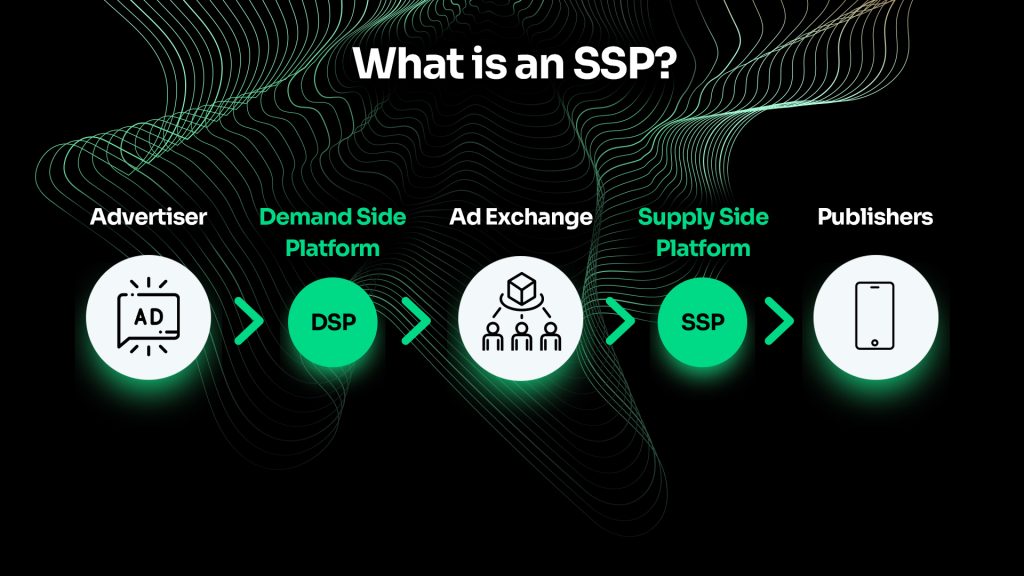Programmatic advertising is a complex ecosystem that serves a broad and vital goal: connecting publishers and advertisers in the efficient buying and selling of online inventory and digital ad impressions.
There are multiple players working to bring both sides together and achieve that goal. On the advertiser side, there are the DSPs and ad networks. In the middle, there are ad exchanges, DMPs, trade desks, agencies and more. On the publisher side, you will find the SSPs, or Supply Side Platforms.
SSPs are one part of a bigger engine that drives the process of online advertising.
Let’s take a deeper dive into what is supply side platform, its features, advantages and best practices. We’ll also examine aspects of demand side vs supply side advertising and see how they are different.
What is a Supply Side Platform (SSP) in Advertising?
In the programmatic marketplace, publishers ‘supply’ ad space and impressions to advertisers. They do so via a Supply Side Platform, or SSP for short.
SSPs facilitate publishers in the sale of ad impressions on their digital assets (ie. website, mobile site, app) to advertisers via automated real-time bidding. The Supply Side Platform connects to numerous ad exchanges, DSPs and ad networks, so publishers can offer their inventory to a wide range of advertisers at once. This helps drive the maximum bid price, boosting potential publisher revenue on websites and apps.
How SSPs Work: Understanding the Basics of the Ad Selling Process
SSPs connect publishers with multiple advertisers on several ad exchanges, ad networks and DSPs simultaneously, in an auction-based process known as Real Time Bidding (RTB).
In an RTB transaction, an advertiser places a bid on publisher inventory via the DSP. The SSP supplies the ad space, based on the publisher’s pre-defined parameters and rules, such as brand safety guidelines, ad formats, ad categories and more.
Behind the scenes, the SSP analyzes the demand sources and selects the highest bidding ad that is best suited to the publisher site, placement, time and viewer. The complete transaction is fully automated and happens in real time. In just a second or two, the winning ad is shown on the web page or app.
SSPs help publishers optimize yield from their ad inventory by hugely broadening the advertiser pool. This enables them to fill their inventory with the best possible ads at the maximum bid, targeted to the highest quality audiences. There are several ways that SSPs can optimize ad inventory and maximize revenue, for example:
- Choosing the best ad network: SSPs use past data to determine which ad network offers the best requirements for a particular transaction.
- Geo optimization: SSPs can ensure that publishers only offer inventory on ad networks that offer relevant and high-potential geographies.
- Frequency capping: SSPs sync with DSPs to limit the number of times that viewers see the ad. This prevents over-exposure and wasted impressions.
SSP vs. Ad network: What’s the Difference?
The programmatic advertising ecosystem is highly complex, and it includes multiple players on the publisher side and advertiser side. A Supply Side Platform is exclusively a publisher-side platform, interfacing with publishers and providing them with access to advertiser demand. An ad network, on the other hand, works as a marketplace for advertisers, connecting them with publishers via the SSP.
What is the Difference between SSP and DSP?
Programmatic buying and selling of online ad impressions requires two parties: publishers (supply) and advertisers (demand), or in other words, supply side vs demand side. The Supply Side Platform is where publishers can offer their ad inventory to ad buyers. On the other hand, the DSP, or the Demand Side Platform, is the advertiser interface, where advertisers place bids for the purchase of ad inventory.
With DSPs, advertisers can manage and optimize their media buying operations across multiple ad exchanges and SSPs on one interface. By centralizing their programmatic ad buying on a DSP, advertisers can boost operational efficiency and enhance the ROI of their ad campaigns.
In short, DSP vs SSP is simply about the two different interfaces used by advertisers and publishers in programmatic media buying.
What are the Benefits of Using SSPs for Publishers?
Publishers competing for ad revenue in the programmatic space rely on supply side platform advertising for the advantages they offer. These include:
- Maximized revenue: SSPs provide publishers with access to a vast network of demand sources, including ad exchanges, trade desks, and DSPs. This increases the pool of potential buyers, resulting in higher competition and bidding for ad inventory. This in turn drives up ad prices and maximizes revenue opportunities for publishers.
- Automated supply: SSPs automate the process of selling ad inventory, giving publishers an efficient and streamlined approach to site or app monetization. Publishers connect their inventory to the Supply Side Platform, which then aggregates demand from multiple sources, manages bidding, and selects the highest bidder for each impression, completely automatically and within seconds. This reduces the manual work for publishers while ensuring optimized transactions.
- Better control of inventory: With SSP advertising, publishers gain increased control over the types of ads that are shown on their websites or apps. Publishers can set down preferences and rules about a range of parameters, such as ad formats, ad quality, ad categories and pricing. By enabling publishers to control and block appropriate ads, publishers can assure brand safety and maintain the quality of their online assets.
- Analytics and reporting: SSPs offer built-in, granular data analytics and reporting on real-time data, such as fill rates, impressions, eCPM, clicks and other key metrics. These insights help publishers monitor and track their activity, better understand who is buying their inventory and optimize their monetization strategy to increase their revenue yield.
Common SSP Features and Capabilities
Supply side platforms typically offer a range of features and capabilities to help publishers improve their efficiency and generate more revenue from their online assets. These include:
Inventory management
SSPs are a powerful tool for publishers to effectively manage and control their ad inventory. They can set preferences and rules about which advertisers and industries they work with, as well as ad formats, ad placements, targeting options, and pricing. This helps to ensure that the right ads are shown to the right audiences at the optimal time. Publishers can also manage the frequency of ad impressions in order to provide the best possible user experience on their app or site.
Integration with demand-side partners
SSPs integrate with a range of demand partners, such as ad networks, ad exchanges, trade desks, DSPs as well as direct advertisers. This opens up a wide pool of advertising partners available to publishers on the Supply Side Platform, increasing exposure and demand for their ads supply and creating more opportunities for monetization.
Yield optimization
A key feature is the use of AI algorithms to optimize supply and increase the potential yield of the publisher’s ad inventory. The SSP aggregates and analyzes past data about ad performance, such as fill rates, bid rates, performance and revenue, to optimize the publisher’s supply strategy. It also integrates dynamic optimization tactics, such as price floors, to effectively increase and optimize publisher yield in real time.
Real-time bidding (RTB)
RTB is a commonly used transaction for digital media buying. SSPs connect with ad exchanges and other demand-side partners to offer real-time bidding for ad impressions, enabling multiple advertisers to compete for the impression simultaneously. With RTB, publishers can drive up bidding and get more revenue for each ad impression, thereby increasing the value of their inventory.
Header bidding
Some Supply Side Platforms offer a header bidding feature, enabling publishers to collect and analyze bids from several different demand partners and DSPs before calling their ad server. With this capability, publishers can manage and optimize their header bidding strategy across all their demand partners via the SSP.
Choosing the Right SSP for Your Business: Factors to Consider
There are many different SSP companies on the market, and each platform has its own unique configuration of features, tools and advantages for publishers. Let’s take a look at the key factors to consider when choosing a supply side ad platform:
Ease of use
Part of the job of SSP programmatic is to make inventory trading simpler and more efficient. Consider the user interface and dashboard, as well as the setup and onboarding process. Make sure to choose a platform that offers advanced features, yet is user friendly at the same time.
Demand integrations
Which demand partners does the SSP ad server offer? Be sure to choose one that integrates with good quality ad exchanges and DMPs, and serves the geographies, audiences and industries that are relevant to your website or in-app advertising revenue goals.
Analytics capabilities
The ability to track, analyze and gain insights from granular performance data is critical to yield optimization of ad inventory. A good SSP will provide robust analytics and reporting features, as well as the ability to customize reports and dashboards according to your KPIs and revenue goals.
Optimization tools and features
Every SSP is slightly different so make sure to check which features and tools are available for optimizing campaigns and maximizing bids in real time. Also, see what type of auctions and exchanges are built into the platform. For example, does it offer private auctions, in which preferred advertisers can bid on inventory at higher pricing before the general advertiser pool? This can be an important feature to drive up bidding and boost revenue.
Brand safety
Finally, brand safety is critical, so make sure to closely examine which security tools the SSP integrates with. Take note of how they manage ad fraud, as well as their stated policies for blocking unwanted ads and advertisers from being displayed on your app or website.
Best Practices for Using SSPs – Tips for Maximizing Revenue
In SSP marketing, publishers who want to maximize the revenue of their ad inventory must stay on the ball at all times. This means continually optimizing audience offerings, targeting options and user experience, and leveraging SSP tools to enhance the attractiveness of their inventory.
Here are our top tips for how to use a Supply Side Platform to boost publisher revenue:
Ramp up the bidding pressure
The key element of maximizing revenue of SSP ads is by maximizing pressure in auctions for ad impressions. There are several ways to do this, such as identifying and filling gaps in mapping, fixing broken ad slots, tracking and responding to performance data in real time, and focusing on high granular data to optimize campaigns in the most focused and effective way.
Dynamic floor pricing
This is a key best practice for publishers to avoid underselling ad impressions, and ensuring they realize the maximum value of their inventory. With fixed floor pricing, publishers risk losing out on advertisers who are willing to bid higher on specific inventory. By using dynamic floor pricing, publishers can capture those higher bids and optimize both their fill rate and revenue.
Build new audiences
Tap into advanced audience building strategies to provide high quality audiences to advertisers, and to draw more interest and action in your inventory. Providing curated supply is one of the ways to optimize the supply path for advertisers and drive up the bidding for ad impressions.
Use contextual targeting
As market competition increases and cookie depreciation makes targeting even harder, advertisers are looking for high-quality, targeted inventory and are even willing to pay more for those impressions. Contextual targeting, based on parameters such as real-time mobile user location, interests, hobbies and more, enables advertisers to effectively target highly relevant audiences, which means higher bids and more revenue for publishers.
The Future of SSPs: Trends and Predictions
As adtech continues to evolve, SSPs can also be expected to advance to higher levels of efficiency. In particular, AI technology will streamline the functioning of publisher-side platforms, and play a crucial role in enhancing the programmatic advertising ecosystem in the future.
As we can already see in many industries and technologies, AI will revolutionize the way SSPs operate, making them more intelligent and efficient. Publisher platforms that integrate artificial intelligence will have the capability for more advanced audience segmentation, targeting, and optimization.
Machine learning algorithms will analyze massively increased amounts of data, which will lead to better ad placements and maximized revenue for publishers. AI will also play a role in monitoring and identifying fraudulent ads, helping to improve transparency and trust in programmatic transactions. This will boost brand safety and enhance ad viewability – a win-win for advertisers and publishers.
When looking at the question, “what is SSP?”, the answer comes from understanding how it fits into the broader landscape of the programmatic ecosystem. For publishers, choosing the right platform and leveraging its features and capabilities to drive up bidding on ad inventory is a key skill for success. And with AI on the horizon, the future will bring even more potential and promise for online publishers to succeed in monetization.




